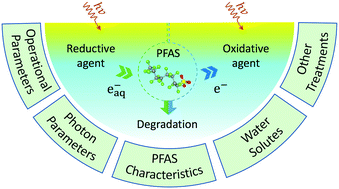Photo-chemical/catalytic oxidative/reductive decomposition of per- and poly-fluoroalkyl substances (PFAS), decomposition mechanisms and effects of key factors: a review†
Abstract
Per- and poly-fluoroalkyl substances (PFAS) are a group of diverse anthropogenic chemicals with a wide range of industrial and commercial applications. Worldwide detection of legacy and emerging PFAS as well as their toxicity and high persistence against most water treatment methods pose a serious environmental challenge. Photochemical processes offer feasible methods for PFAS decomposition due to their simplicity, operating in mild conditions, and high degree of efficacy. This paper identifies and compares mechanisms of photo-chemical/catalytic oxidation and reduction of different PFAS structures. The effects of adding different oxidative and reductive mediators – inorganic ions (e.g., persulfate and sulfite), organic solutes (e.g., aminopolycarboxylic acids), and photocatalysts – are comprehensively studied. Oxidative agents (e.g., SO4˙− and h+) and hydrated electrons (eaq−) are identified as the main active agents carrying out photo-oxidative and -reductive processes, respectively. PFAS are oxidatively degraded through one electron transfer to photo-induced oxidants followed by functional group detachment and chain shortening. On the other hand, cleavage of the C–F bond, functional group detachment followed by chain shortening, and center C–C or C–O bond scissions are proposed reductive pathways of PFAS decomposition upon reaction with eaq−. Moreover, the effects of key parameters on photodegradation of PFAS including operational parameters (i.e., pH, dissolved oxygen, and temperature), irradiation (i.e., wavelength and intensity), PFAS concentration and structure, and various water solutes (i.e., organic and inorganic matters) are evaluated in detail. In addition, the synergistic effects of combining other remediation processes, i.e., removal and degradation processes, with photochemical processes and benefits and challenges of such combinations are presented.

- This article is part of the themed collections: PFAS: cleaning up drinking water, Best Papers of 2022 from RSC’s Environmental Science journals and Best Papers 2022 – Environmental Science: Water Research & Technology


 Please wait while we load your content...
Please wait while we load your content...